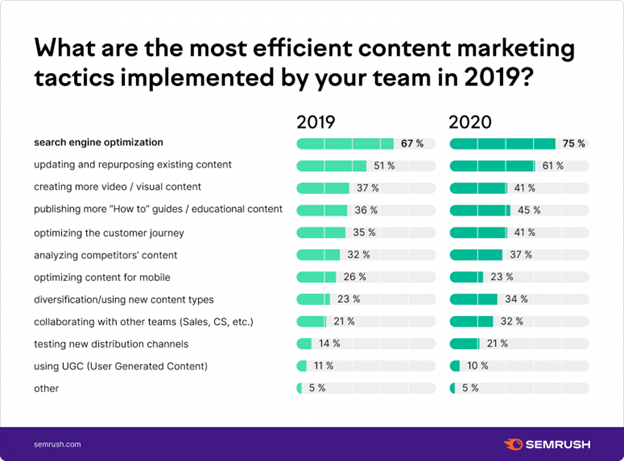Every expressive form you use to attract new customers—text, images, videos, information on your website—falls under the same category known as content. Your connection with the audience and your position on the market highly depends on the content you publish.
The relevance of content in the business world has led us to a process that any successful company needs to employ. That process is creating a content strategy.
A content strategy ensures that you take calculated steps that minimize risks and maximize content efficiency. It allows you to move past improvised content publishing and develop a plan that brings results.
With each year, there is a growth in the number of companies that implement content marketing strategies. In 2019, 77% of companies had confirmed that they have such a strategy, while in 2020 that number rose to 84%.
Where does this increase come from? It comes from the growing recognition of the relevance of creating and publishing content based on a carefully developed “game plan.”
If you want to build brand authority, reach new markets, gain loyal customers, improve your team’s collaboration, and get better ROI, you know what you must do—create a killer content strategy.
Are you ready to turn that idea into reality? Then, these are the steps you need to take.
1. Set Your Goals
Merriam-Webster dictionary defines strategy as “the art of devising or employing plans or stratagems toward a goal.” As you can tell, a strategy is designed to accomplish a certain goal. Therefore, your path to employing a powerful strategy should start with defining that goal.
So, here is the big question: What do you want to achieve with your content?
Do you want to spread brand awareness? Grow your list of subscribers? Increase sales?
Be specific about what kind of result your content needs to bring.
To motivate action, you should provide a realistic timeline for achieving those goals. For example, by when can you expect to see that increase in traffic once you employ the strategy? Don’t leave yourself too much time for overthinking. Instead, set a loose deadline that will inspire you to put your content strategy in motion.
Once you decide on the goals, introduce them to your team. Your efforts need to have the same intent if you want your content strategy to be successful.
2. Understand Your Audience

Image Source: pixabay.com
Writing down your audience’s demographics won’t help you create personalized content. You need to dig deeper.
The key to sourcing just the right topics and crafting impactful content is understanding your target audience.
Get a better idea of the people you want to win over. Aside from the basics (age, gender, location, education, employment, etc.), focus on the audience’s:
- Pain points
- Desires
- Needs
- Wants
- Hobbies
- Guilty pleasures
- Bad habits they want to break
- Good habits they want to develop
- Likes and dislikes
Based on the findings, you can plan and create content that resonates with your audience. That is the content that will inspire people to take action.
You must be thinking, “How can I gather such personal information?” Well, thanks to social media, forums, and analytical platforms, this isn’t an impossible task.
Here are some ideas on how you can get a deeper understanding of your audience:
- Conduct polls on social media
- Send engaging surveys to your email subscribers
- Use Answer The Public platform to find out which search queries are most popular in your niche
- Browse through Facebook groups and forums related to your niche
Get that “insider information” and shape your content strategy according to the audience’s needs. The time you invest in the research will pay off in the form of better results.
3. Choose Distribution Channels
Where your content will be published is a big decision. Distribution channels influence the frequency of posting and the type of content you must create. So, you have to be clear about this from the very start.
Research where your target audience “hangs out” online to choose suitable platforms for your content. For example, an older audience who likes informative content will prefer frequent blog posts. In turn, a younger public typically navigates towards visual platforms like Instagram and TikTok.
Observe the demographics on every platform you are considering. Also, take a look at where your successful competitors mainly post their content. Competitors’ strategy can teach you a lot. Instead of diminishing their success, observe what works with your target audience. Ultimately, you are trying to win over the same people. Their actions can prevent you from making costly mistakes.
After you get the picture of the best places to reach your audience, create a list of the distribution platforms you plan to use. With that list in front of you, define the amount of content you want to publish and organize your team to start creating it.
4. Define the Best Content Formats for Your Audience
Make sure that you cleverly invest your time and effort. Gain an understanding of what type of content performs best with your consumers.
However, focusing your efforts on a single content format isn’t a good approach. You want to keep your audience engaged by providing them with variety. Your content strategy should comprise different types of content for the best results.
Here are some content marketing tools you can include in the strategy:
- Blog posts
- Social media posts
- Photos
- Infographics
- Emails
- PPC (pay-per-click advertising)
- E-books
- Video tutorials
- Live streams
- Quizzes
- Guides
- Q&As
To position yourself as a credible and authoritative brand, you must base your content creation on credible resources.
Sharing false information can diminish your reputation. Use only reputable sources for informative content. Look for free essay samples if you need inspiration for educational content. Or gather statistics from academic publications for creating infographics.
Bear in mind that the budget will influence the type of content you create. It’s better to create high-quality blog posts and infographics than low-quality videos. Always keep the content’s quality at a high level. Even if that means that you must put a pause on some more expensive content ideas.
5. Count in the SEO
How high is SEO ranked on your list of content priorities? If you still didn’t turn it into a requirement, now is the time to do it. Make sure that you find a time and place for SEO in your content strategy.
Search engine optimization (SEO) is crucial for bringing in relevant organic traffic. No matter what your goal is, increasing traffic can help you achieve it.
According to SEMRush’s survey, companies claim that SEO is the most efficient content marketing tactic. Why? Because without traffic, you’ll have no opportunity to convert. SEO builds the bridge between your content and your target audience.

Image Source: semrush.com
Bring SEO experts to your team. Their task should be to optimize the content before publishing or make necessary changes to make content more discoverable.
6. Plan Ahead
Outline how and when you plan to post content. Build this plan according to your audience. That is, count in when your audience is online, how often they would like to get new posts, and what kind of posts they want to see the most.
Surveys and polls can help you gather this information directly from the audience. Why make assumptions when you have multiple platforms that allow you to ask the audience what they want. You can also take into consideration your competitors’ frequency of posting.
Create a clear and sharable content calendar. Every member of your team should be able to access it and keep track of the progress.
Enter relevant dates, holidays, and events that demand specialized content. The calendar will remind you to start creating personalized content on time. That’s the beauty of planning. It won’t let you forget your content responsibilities.
7. Pick Your Tools Wisely
Putting your strategy in motion will be much easier with the help of useful tools. The digital age has blessed us with tools that can automate and streamline your content strategy.
The tools you can use can have different purposes, such as:
- Content planning (e.g. Gather Content)
- Content creation (e.g. Canva)
- Text editing and proofreading (e.g. Grammarly)
- Video editing (e.g. Nero Video)
- Scheduling content posts (e.g. SproutSocial)
Find tools that work best for your team. When you try out their efficiency, you won’t be able to imagine a life without them.
Wrapping Up
For businesses who thrive to grow and improve themselves, content strategy is no longer a choice—it is a necessity. Your audience deserves more than sporadic posts with inconsistent quality. They deserve excellence, and your content strategy can help you deliver it.
Author Bio
Alison Lee is a content marketing specialist, freelance writer, and editor. In addition to being an expert in digital marketing, she is enthusiastic about writing as well. Her passion is expressed through different writing challenges that she relentlessly tackles. She likes to stay up to date with marketing trends by attending conferences across the world.
